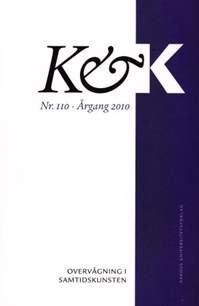OVERVÅGNINGENS KUNST - OVERVÅGNINGSDYSTOPIER OG INTERFACEBEGÆR I DET URBANE RUM I 1984, FACELESS OG ANDRE URBANE INTERFACES
DOI:
https://doi.org/10.7146/kok.v38i110.15770Keywords:
overvågning, dystopi, Orwell, Luksch, InterfaceAbstract
THE ART OF SURVEILLANCEFor many years surveillance was perceived in a negative way, but this has changed and we increasingly are surveilled by cameras and sensors and our behaviour on-line is logged and tracked by both companies and (inter-)national intelligence. Far from generating overwhelming protests, this development is often furthered by people willingly posting personal and private data to commercial services and companies on the web. Consequently today, surveillance seems unavoidable and an integrated part of the different social and urban interfaces spreading around us. This article will discuss this cultural shift in the perception of surveillance and follow how the cultural perception of surveillance has changed from George Orwell’s dystopian 1984 to Apple’s liberating 1984 in the advert for the first Macintosh and to contemporary urban interfaces. It will do so by discussing contemporary urban surveillance art with a focus on Manu Luksch’ film Faceless (2007), which is a film made exclusively from ready-made surveillance camera footage. Besides a critical surveillance narrative, this film also shows dehumanised images of an invisible sociality that have a paradoxical beauty.
Downloads
Published
2010-12-29
How to Cite
Pold, S. B. (2010). OVERVÅGNINGENS KUNST - OVERVÅGNINGSDYSTOPIER OG INTERFACEBEGÆR I DET URBANE RUM I 1984, FACELESS OG ANDRE URBANE INTERFACES. K&K - Kultur Og Klasse, 38(110), 9–26. https://doi.org/10.7146/kok.v38i110.15770
Issue
Section
Articles
License
Tidsskriftet følger dansk ophavsret.





